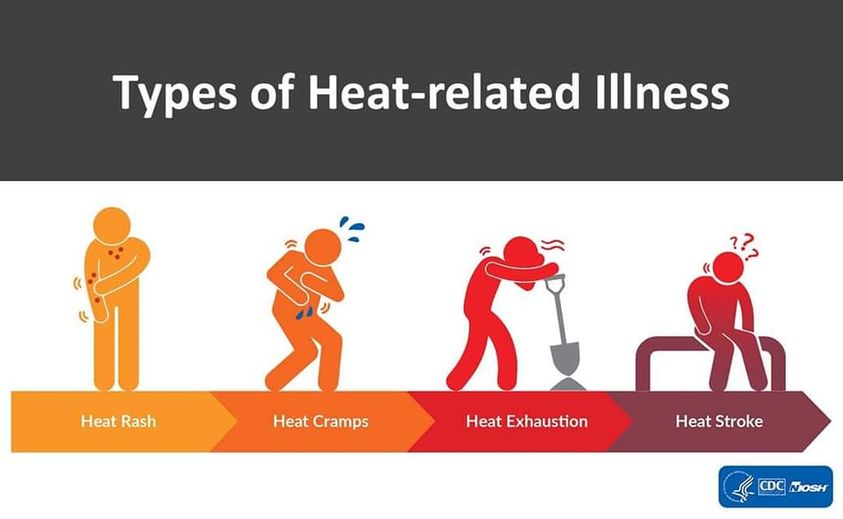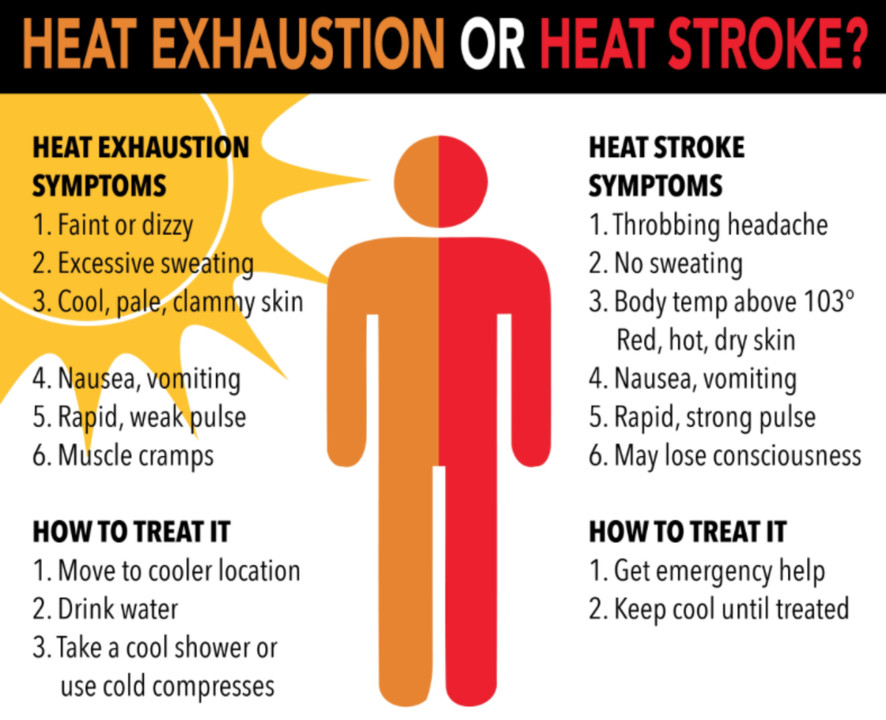Scorching temperatures pose a serious threat to construction site safety. The physical exertion required for many tasks, combined with exposure to direct sunlight and often heavy personal protective equipment (PPE), creates a perfect storm for heat stress.
This is a serious concern, as evidenced by the sobering statistics: Between 2011 and 2022, an average of 40 workers died each year from environmental heat exposure in the U.S. Additionally, an estimated average of 3,389 workers annually suffered heat-related injuries or illnesses severe enough to cause missed workdays from 2011 to 2020.
Construction workers are particularly susceptible to heat stress because they often work long hours outdoors in hot and humid conditions.
To manage this, it’s important to understand heat stress in construction, recognize its symptoms, and implement preventive measures to safeguard workers. This article will give an in-depth overview of construction heat safety, the risks involved, and practical tips to protect workers from the dangers of excessive heat throughout the summer months.
Key Takeaways
Here are the key tips and best practices to ensure construction heat safety:
- Hydration: Drink water frequently, avoid dehydrating drinks, and replenish electrolytes.
- Clothing: Wear lightweight, light-colored, breathable clothing, hats, and sunscreen. Consider cooling vests or UV-protective gear.
- Work Scheduling: Schedule strenuous tasks during cooler hours, increase rest breaks, and gradually acclimate new workers.
- Cool Zones: Provide shaded areas, cooling stations with fans and misters, and access to air conditioning if possible.
- Training: Educate workers on recognizing heat stress symptoms, emergency procedures, and basic first aid.
- Monitoring: Track the heat index and regularly check on workers for signs of heat stress. Have an emergency response plan in place.
What is Heat Stress in Construction?
Heat stress is a serious condition that occurs when the body’s temperature regulation system becomes overwhelmed due to prolonged exposure to high temperatures and humidity. In construction, where physical exertion is the norm, the risk of heat stress is amplified and can result in one or a few of the following heat-related illnesses:
Heat Exhaustion
This condition arises when the body loses an excessive number of fluids and electrolytes, primarily salt, through sweat. As sweat evaporates, it cools the body. However, during strenuous activity in hot weather, sweating can become so excessive that it leads to dehydration and an imbalance of electrolytes. If left untreated, heat exhaustion can progress to heat stroke, a much more serious condition.
Heat Stroke
A medical emergency characterized by a core body temperature exceeding 104°F (40°C) and the inability to regulate temperature. Heat stroke can occur rapidly and requires immediate medical attention.
Heat Cramps
These are painful, involuntary muscle spasms in the legs, arms, and abdomen that are also caused by electrolyte imbalance from excessive sweating. In fact, heat cramps are often a warning sign of impending heat exhaustion and heat stroke.
Heat Rash
A red, itchy skin irritation caused by blocked sweat ducts. Heat rash is most common in areas where clothing traps sweat, such as the groin, armpits, and neck. While not as serious, it can be incredibly uncomfortable.

Recognizing the Warning Signs of Heat-Related Illness
Early detection and intervention can be huge differentiating factors for preventing serious heat-related illnesses. Be aware of the following common warning signs:
- Dizziness, light-headedness, confusion, irritability, or difficulty concentrating. Pay close attention to changes in mood or behavior, as these can be early indicators of heat stress, especially in older workers or those who are not acclimatized.
- Nausea, vomiting, or loss of appetite. These symptoms can also be accompanied by excessive sweating or a feeling of nausea without vomiting.
- Excessive sweating, clammy skin, or cold, pale, and moist skin (in heat stroke). Be aware that sweating can vary depending on the individual and the environment. Some people may sweat profusely, while others may sweat very little. The absence of sweat should not be solely relied upon to rule out heat stress.
- Muscle cramps, weakness, or fatigue. Muscle cramps are often the first noticeable symptom of heat stress, and they can be painful and debilitating.
- Headaches are a common symptom of heat stress and dehydration.
- A rapid heartbeat is the body’s attempt to increase circulation and deliver more blood to the skin’s surface for cooling.
If you or a coworker experience any of these symptoms, take immediate action to cool the body down and replenish fluids. Move to a cool, shaded area or air-conditioned space. Drink plenty of water or electrolyte-rich beverages. Apply cool, wet clothes or ice packs to the body. Seek medical attention if symptoms are severe or don’t improve quickly.

Construction Heat Safety Tips and Best Practices
Heat safety is an important component of construction injury prevention and requires a combination of preventative measures and smart work practices. Here’s a toolbox of heat safety tips for construction workers to help beat the heat:
1. Hydration
The body loses a significant amount of fluid through sweat, and it’s important to replace these fluids regularly and properly.
- Water: Ensure workers always have access to potable water. They should drink small amounts frequently, rather than large amounts less often.
- Avoid Dehydrating Beverages: Steer clear of drinks that can cause dehydration, such as coffee and sugary sodas.
- Electrolytes: Provide electrolyte-replenishing beverages, especially when working for long periods or in extreme heat but be mindful of their sugar content.
- Hydration Schedule: Encourage a hydration schedule where workers drink water every 15-20 minutes.
2. Clothing and Personal Protective Equipment (PPE)
The right clothing significantly impacts how the body handles heat and protects you from the sun’s harmful rays.
- Lightweight, Light-Coloured, and Breathable: Use lightweight, breathable clothing that is light in color to reflect rather than absorb heat.
- Head Protection: Equip workers with wide-brimmed hats or neck flaps to protect them from direct sunlight.
- Cooling Vests: Consider using cooling gear for construction workers, like cooling vests, that can help lower body temperature.
- UV-Protective Clothing: Alternatively, consider clothing with built-in UV protection to reduce the risk of sunburn.
3. Sunscreen
Construction workers spend long hours under the sun, making sunscreen a crucial part of their daily routine to protect against UV radiation.
- Choose Broad-Spectrum Sunscreen: Use a sunscreen that offers broad-spectrum protection against both UVA and UVB rays.
- Apply Generously and Regularly: Apply a generous amount of sunscreen to all exposed skin areas 15-30 minutes before going outside. Reapply every two hours, or more frequently if sweating heavily.
- SPF 30 or Higher: Opt for a sunscreen with an SPF of 30 or higher for adequate protection.
4. Work Scheduling
Adjusting work schedules can help minimize heat exposure.
- Early or Late Shifts: Schedule strenuous tasks during cooler parts of the day, such as early morning or late afternoon.
- Rest Breaks: Increase the frequency and duration of rest breaks in shaded or air-conditioned areas.
- Acclimatization: Gradually increase workloads for new workers or those returning from an absence to help them acclimatize to the heat.
- Rotate Workers: If possible, rotate tasks among workers to limit the amount of time each person spends in direct sunlight or performing strenuous activities.
5. Cool Zones
Designate and equip areas where workers can cool down.
- Shade Structures: Set up tents or canopies to provide shade during breaks.
- Air-Conditioned Areas: Alternatively, if possible, provide access to air-conditioned spaces like trailers or break rooms.
- Cooling Stations: Equip cooling stations with fans, misting systems, and cold packs.
6. Training and Awareness
Knowing how to act when it comes to heat-related illness can mean the difference between a safe workday and a medical emergency. Workers should be well-versed in:
- Recognize Symptoms: Train workers to recognize the signs and symptoms of heat-related illnesses in themselves and others.
- Emergency Procedures: Ensure workers know the emergency procedures if someone shows symptoms of heat stroke or heat exhaustion.
- First Aid: Equip workers with basic first aid knowledge to handle heat-related emergencies until professional help arrives.
7. Monitoring and Responding to Heat Stress
Keeping tabs on potential heat-related risks is a proactive way to ensure the safety and well-being of workers.
- Heat Index Monitoring: Keep track of the heat index. Use tools like the OSHA-NIOSH Heat Safety Tool app to monitor the heat index and adjust work practices accordingly.
- Check-In Systems: Implement regular check-ins to ensure workers are not experiencing symptoms of heat stress.
- Buddy System: Alternatively, implement a buddy system where workers look out for each other and report any signs of heat stress.
- Immediate Response Plan: Have a plan in place for immediate action if a worker shows signs of a heat-related illness, including access to medical help.

Conclusion
Construction heat safety is a responsibility that shouldn’t be taken lightly. While the strategies outlined in this article provide a solid foundation for managing heat stress, it’s equally important to have a comprehensive plan in place for managing heat-related emergencies. This is where our construction site medical services aim to make all the difference. With access to healthcare professionals from anywhere, 24/7, you can ensure your workers receive the care they need, when they need it. If you’re looking to ensure your workers have the support they need during the hot summer months, we encourage you to get in touch with us to explore our telemedicine-led onsite industrial medical services.
Frequently Asked Questions
What is heat stress in safety?
Heat stress is a condition that occurs when the body’s ability to regulate its temperature is overwhelmed by excessive heat exposure. In the context of workplace safety, it is a significant hazard, particularly in industries like construction where workers are exposed to hot environments.
What are the OSHA regulations for heat exposure?
While there are no specific OSHA standards for heat exposure, the agency does require employers to provide a safe workplace and protect workers from recognized hazards. Employers are expected to take reasonable steps to prevent heat-related illnesses, including providing training on heat stress, encouraging water breaks, and scheduling work during cooler hours when possible.
How long is it safe to work in the heat?
There is no definitive answer to this question as it depends on various factors, including the temperature, humidity, intensity of work, individual fitness levels, and acclimatization. However, it’s generally recommended to take regular breaks and monitor for signs of heat stress.
What is the best treatment for heat stress?
The best treatment for heat stress is to move the affected person to a cooler area, rehydrate with water or sports drinks, and cool the body with wet towels, fans, or ice packs. If symptoms are severe or do not improve, seek medical attention immediately.
How should employers prepare for and respond to heat-related emergencies?
Employers should have a heat illness prevention plan in place, including measures like providing shade, water, and rest breaks, monitoring weather conditions, and training workers on recognizing and responding to heat stress. They should also have procedures for emergency response, including contacting medical services if needed.


